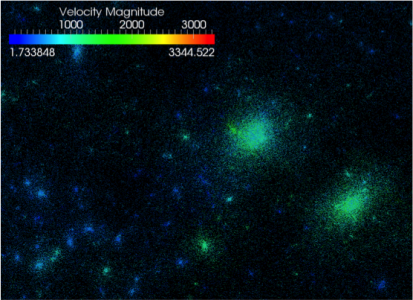 Over at OLCF, Katie Elyce Jones writes that researchers are using the Titan supercomputer to create a comprehensive sky catalog of the development of the universe.
Over at OLCF, Katie Elyce Jones writes that researchers are using the Titan supercomputer to create a comprehensive sky catalog of the development of the universe.
Basically what the code does is follow the formation of structure in the universe,” said Salman Habib, project leader and high-energy physicist and computational scientist at Argonne National Laboratory (ANL). “And the idea is to get very-high-accuracy simulations of the universe so you can compare them to observations of the sky.”
To simulate cosmic structure, the ANL research team and its collaborators developed a modular, high-performance computing (HPC) code called HACC (for Hardware/Hybrid Accelerated Cosmology Code) designed for diverse HPC architectures. HACC requires petascale computing to “evolve” trillions of interacting particles and is the first large-scale cosmology code that can run on a hybrid CPU/GPU supercomputer, as well as on multicore or many-core architectures.
The code’s exceptional performance on the OLCF’s 27-petaflop, hybrid CPU/GPU Cray XK7 supercomputer, Titan, located at Oak Ridge National Laboratory, as well as on the IBM Blue Gene/Q machines Sequoia (at Lawrence Livermore National Laboratory) and Mira (at ANL), earned the project a finalist nomination for ACM’s Gordon Bell Prize. The award recognizes outstanding achievement in high-performance supercomputing applications, and this year’s winner will be announced at the SC13 supercomputing conference in November. Four of the six finalists, including HACC, ran on Titan.
Pushing the boundaries of what is possible in HPC today, the most computationally demanding calculations in HACC run at performance levels that translate to more than 25 petaflops on Titan and at an estimated 10 petaflop sustained performance. Such extreme performance is needed to simultaneously capture the large scales and the low-level details that modern cosmology requires.
Read the Full Story.




